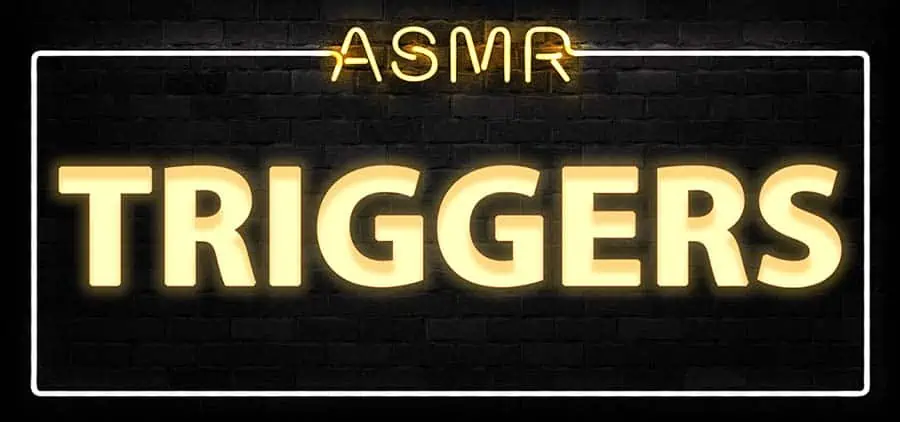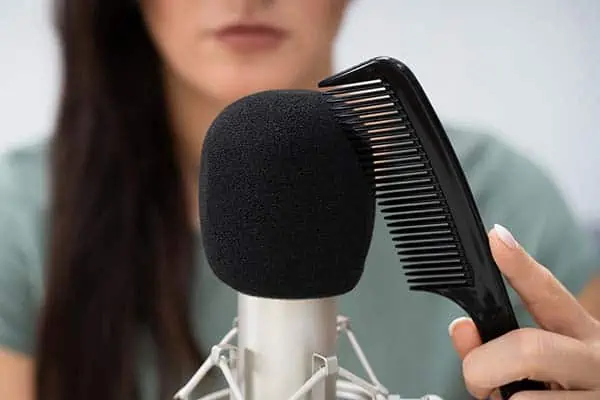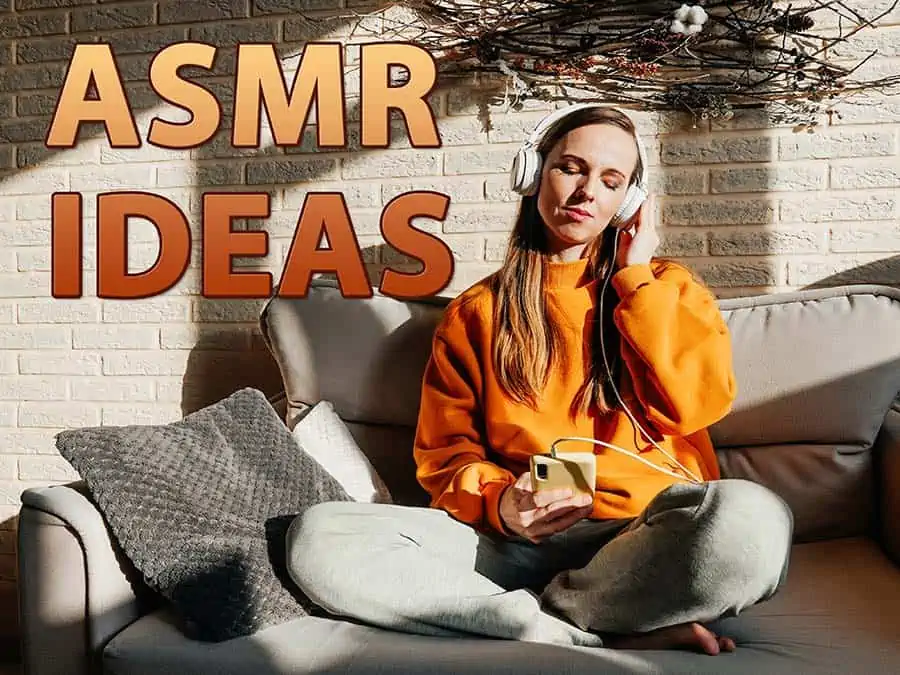DIY Video Studio is supported by its readers who use the affiliate links or ads on this site. As an Amazon Associate, I earn from qualifying purchases. Thank your support if you use any of the links.
ASMR is a relaxing and pleasurable sensation triggered by sounds, sights, and touches that can reduce stress and improve sleep. From soothing speech to calming rhythms, ASMR triggers offer a range of possibilities for recording relaxation and stress relief YouTube videos.
So, if you’re a beginner looking to create ASMR content, I’ve created an ASMR triggers list to get you started.
What are ASMR triggers?

ASMR triggers are stimuli that can produce various pleasurable or feel-good sensations in the viewer or listener. These can be a tingling sensation on the skin or a feeling of relaxation that can promote restful sleep.
The experience of ASMR is highly individual and the effectiveness of triggers is not universal. In fact, some triggers will affect more people than others. But some triggers that affect a smaller proportion of folks can still be highly effective for those individuals.
Even though the triggers may vary from person to person, your goal as an ASMR artist is to create videos that produce an enjoyable, relaxing, and soothing experience for your specific audience.
When you have finished reading this article, you might like to watch my YouTube video
Basic ASMR triggers from real academic research
Although ASMR is a relatively recent area of psychology research, the subject is attracting academic interest. As more academic papers are being published, the consensus is that it is a real phenomenon that is worthy of further investigation.
In 2018 one article published in PLoS One included a table with a list of common ASMR triggers. These included:
- Hair being cut
- Hair being played with or brushed
- Hand movements
- Interaction with face or head
- Lip smacking
- People speaking softly
- Scratching sounds
- Tapping on hard surfaces
- Watching and hearing someone eating
- Watching people do things in a careful, attentive way
- Water sounds
- Whispering
If you’re new to ASMR content creation and looking for some ideas, this trigger list is a great place to start. It offers plenty of scope for creating YouTube videos with both aural and visual elements that are both relaxing and soothing content.
ASMR content creation ideas for beginners
If you’re new to ASMR it can be intimidating to know where to start. But don’t worry – it’s easier than you think!
The ASMR community is now an established one, so you can look to the work of established ASMR artists for inspiration. Now don’t get me wrong, I’m not suggesting that you blatantly copy their work. Instead, use their videos as inspiration for your own. There’s nothing wrong with that. In fact, artists, composers, musicians, and writers have often said they have been inspired by those who came before.
So, as a beginner, don’t take a random leap into the unknown. It’s better to start off with well-established triggers to at least get some experience under your belt. You can do some research into what is already known to work, or just look at the list of triggers in the previous section.
Example 1: Using whispering as an ASMR trigger
One of the easiest triggers to pick is whispering. I bet at some time in your life you will have whispered something, so you’ve already got experience with this trigger, you just need to expand upon it.

Practice speaking softly and slowly. Whispering is a crucial element of ASMR, so it’s important to get the delivery right. Take some time to practice speaking in a whisper before starting the recording. Experiment with different types of whispers, such as soft and gentle whispers, breathy whispers, or more energetic whispers. You can also try layering whispers by recording multiple tracks and blending them together in post-production.
In a whispering ASMR video, obviously, you can talk about a variety of topics, but remember ASMR is meant to be a relaxing and pleasurable sensation. So, it would make sense that you choose topics that are soothing, calming, and relaxing. Don’t just talk about your topic but be descriptive to create visual imagery in the listener’s mind. By adding visualization you’ll be making the ASMR work on multiple levels.
You can whisper about personal anecdotes or describe a visit to a beautiful place. Alternatively, use role-play and pretend to be a hairdresser, masseuse, or therapist. It’s important to keep in mind that ASMR videos are meant to be a sensory experience for the viewer, so focus on creating a pleasant and relaxing atmosphere by using gentle whispers and soothing sounds.
Example 2: Using scratching as an ASMR trigger
Although I’m not going to go through the entire trigger list, I will include one more item, and I’ll choose scratching sounds. Gently use your nails on various surfaces, such as paper, fabric, or the grille on a microphone, to create soft scratching sounds.

To add variety to this, try using alternatives to your nails. Use a comb, hairbrush, or makeup brush; each one will produce a different type of scratching sound.
Slowly brushing your hair also produces a kind of scratching sound, which can be intensified by having applied some hairspray first. With such videos, you can incorporate other ASMR triggers such as the whispering I already described. This time, you can describe what you are doing, what you want your hair to look like, and how the brushing feels. Again, remember it is meant to be relaxing, so go slower than when brushing your hair normally.
You can see that you can make dozens of variations from the triggers list, and remember, the list doesn’t include every known ASMR trigger. It’s just a list that those academics put together for their research. There are plenty of other triggers out there. One is crunching or crinkling noises, the sort you get when manipulating foil, plastic, or paper packaging. You just need to mix in some creativity and a bit of experimentation to produce your own unique ASMR videos for your audience.
Tips for developing your own unique ASMR content
Finding your own trigger sounds and activities as an ASMR artist can be a process of trial and error, as different people have different triggers and preferences. Once you find a basic trigger you can then follow an interactive process to fine-tune it.
Experiment with different sounds and activities to see how they affect your audience. You can ask them directly for their reaction by leaving a comment or using the analytics YouTube provides. You can dive into the retention graph in the analytics or for quick results, look at the new engagement graph that appears above the progress bar of the video as you scrub along it. If the graph is high, it means that part of the video has been frequently re-watched. If you’ve used a different trigger in each part of the video, the engagement graph can quickly help you find which parts are of most interest to your viewers.
Don’t forget it’s not just sounds that are ASMR triggers.
You could also try different activities, such as drawing, writing, or playing with tactile objects, to see if they have a relaxing or calming effect on your audience. Be open-minded and patient as you search for trigger sounds and activities, as it may take some time and experimentation to find the ones that work best for your channel. The key to finding your own trigger sounds and activities as an ASMR artist is to be curious and willing to try new things.
Enhance your content ideas with different microphone techniques
Experimenting with different microphone techniques can be a terrific way for an ASMR artist to enhance the audio quality of their videos and create a more immersive experience for their audience.
It’s common for an ASMR artist to begin by using a cardioid microphone. This is a unidirectional microphone, which is most sensitive in front of the microphone capsule. This allows the recording to focus on sound coming directly from in front of the microphone and rejecting sound from the sides and rear. This can be useful if you are recording ASMR videos at home and not in a sound-treated studio since it will help reduce background noise and isolate the sound being recorded.
Another technique new ASMR artists can experiment with is using a stereo microphone or a cross-pair of microphones that will produce a stereo aural image. This can be helpful for creating a more realistic and immersive soundscape for your videos.
In addition, you could try the more advanced technique of binaural recording. A binaural microphone is one that mimics the way a human hears a sound. The setup uses two small, artificial ears with microphone capsules inside each ear canal. When used, it captures stereo audio in a way that mimics how a person’s own ears perceive sound. This can create a 3D audio effect that makes it feel like the sounds are coming from all around the listener, adding to the immersion and realism of the ASMR experience.
Experimenting with these different microphone techniques can be a fun and rewarding way of improving your videos and the experience for your audience.
Final thoughts
Do not be ashamed to learn from others and be inspired by their work, although this does not mean copying already successful videos. Remember to experiment and have fun with different triggers and see what works best for you and your audience. Once you have a general idea of what you want to create, think about what ASMR triggers work best for your audience. Furthermore, question what microphone techniques will enhance the effect you’re creating. Finally, remember the best ASMR content comes from creators who are passionate and authentic.
Are you looking for the ideal beginner ASMR microphone? Then check out the Blue Yeti.
- Custom three-capsule array: This professional USB mic produces clear, powerful, broadcast-quality…
- Blue VOICE software: Elevate your streamings and recordings with clear broadcast vocal sound and…
- Four pickup patterns: Flexible cardioid, omni, bidirectional, and stereo pickup patterns allow you…
- Onboard audio controls: Headphone volume, pattern selection, instant mute, and mic gain put you in…
Last update on 2024-10-03 / Affiliate links / Images from Amazon Product Advertising API
Source: More than a feeling
About the author: Tosh Lubek is a multi-award-winning broadcaster, writer, and video producer, with 40 years of experience in professional broadcasting and has been using Canon video and stills cameras since 2010. He has worked with radio and TV broadcasters, advertising agencies, and direct clients on a variety of projects including radio and television advertising, online video production, corporate videos, award ceremony motion graphics, and theme park sound design. Tosh has won numerous awards, including a Radio Academy Awards Gold Sony, a Gold, Silver, and Bronze World Medals in the New York Festivals International Advertising Awards. Since about 2007 he has been creating YouTube videos. Tosh has been a sponsor of the “video booth” at HashTag Business Events across the UK.
Recent Posts
Fix Blue Yeti Corrupted Firmware or USB Advanced Audio Device Issue in Windows
Author: Tosh Lubek Published: 2nd October 2024 "Help! My Blue Yeti Isn't Working Right!" That was the urgent message I received from one of my readers who was facing a frustrating issue...
Premiere Pro Editors STOP Dragging Clips WRONG! Edit 10x FASTER
Hey there, Premiere Pro users! If you're dragging your video clips from the project panel to the timeline listen up, there's a better way! The program monitor holds some hidden editing superpowers...




